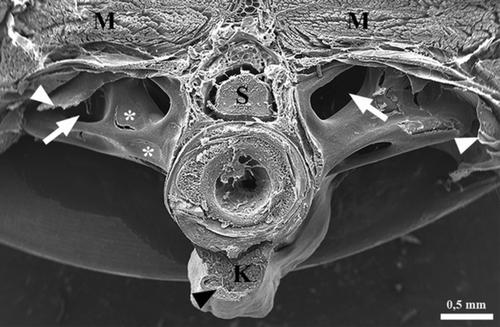当前位置:
X-MOL 学术
›
J. Morphol.
›
论文详情
Our official English website, www.x-mol.net, welcomes your
feedback! (Note: you will need to create a separate account there.)
The gas bladder of Pantodon buchholzi : Structure and relationships with the vertebrae
Journal of Morphology ( IF 1.5 ) Pub Date : 2020-10-09 , DOI: 10.1002/jmor.21271 José M. Icardo 1 , Gioele Capillo 2 , Eugenia R. Lauriano 3 , Michal Kuciel 4 , Marialuisa Aragona 2 , Maria Cristina Guerrera 2 , Giacomo Zaccone 5
Journal of Morphology ( IF 1.5 ) Pub Date : 2020-10-09 , DOI: 10.1002/jmor.21271 José M. Icardo 1 , Gioele Capillo 2 , Eugenia R. Lauriano 3 , Michal Kuciel 4 , Marialuisa Aragona 2 , Maria Cristina Guerrera 2 , Giacomo Zaccone 5
Affiliation

|
We report here on the histological and structural characteristics of the gas bladder, the vertebral morphology, and the bladder–vertebra relationships of the butterfly fish, Pantodon buchholzi. The bladder opens at the boundary between the pharynx and the esophagus by a middle slit. A pneumatic duct is absent. The bladder shows a dorsolateral wall that adapts to the anfractuosities of the coelomic cavity and a ventral wall in contact with the abdominal organs. The vertebral bodies are formed by an hourglass shaped autocentrum, and by an arcocentrum reduced to several longitudinal ridges. The transverse processes adopt the structure of a cage whose walls are formed by bone trabeculae of variable size and distribution pattern. The dorsolateral wall of the bladder is a membrane that covers the kidney, adapts to the irregular shape of the vertebrae, and invades the transverse processes at several points before extending laterally. However, invasion of the vertebral bodies, the presence of a labyrinth, or the formation of respiratory parenchyma were not observed. The luminal surface of this wall is a thin respiratory barrier containing a single epithelial cell type. In addition, the wall contains numerous eosinophils that may be implicated in immune defense. The bladder ventral wall is a membrane rich in collagen, vessels, smooth muscle, and nerves that lacks a respiratory barrier. Its luminal surface contains ciliated and nonciliated cells. The two cell types appear implicated in surfactant production.
中文翻译:

Pantodon buchholzi 的气囊:结构和与椎骨的关系
我们在此报告蝴蝶鱼 Pantodon buchholzi 的气囊的组织学和结构特征、椎骨形态和膀胱-椎骨关系。膀胱在咽部和食道之间的边界处通过一个中间狭缝打开。没有气动管道。膀胱显示出适应体腔和腹壁与腹部器官接触的腹壁的背外侧壁。椎体由沙漏形的自体中心和减少为几个纵向脊的弧中心体形成。横突采用笼状结构,其壁由不同大小和分布模式的骨小梁形成。膀胱的背外侧壁是覆盖肾脏的膜,适应不规则的椎骨形状,并在横向延伸之前在几个点侵入横突。然而,没有观察到椎体的侵入、迷路的存在或呼吸实质的形成。该壁的管腔表面是包含单一上皮细胞类型的薄呼吸屏障。此外,该壁含有许多可能与免疫防御有关的嗜酸性粒细胞。膀胱腹壁是一层富含胶原蛋白、血管、平滑肌和神经的膜,缺乏呼吸屏障。它的管腔表面包含纤毛和非纤毛细胞。这两种细胞类型似乎与表面活性剂的生产有关。或未观察到呼吸实质的形成。该壁的管腔表面是包含单一上皮细胞类型的薄呼吸屏障。此外,该壁含有许多可能与免疫防御有关的嗜酸性粒细胞。膀胱腹壁是一层富含胶原蛋白、血管、平滑肌和神经的膜,缺乏呼吸屏障。它的管腔表面包含纤毛和非纤毛细胞。这两种细胞类型似乎与表面活性剂的生产有关。或未观察到呼吸实质的形成。该壁的管腔表面是包含单一上皮细胞类型的薄呼吸屏障。此外,该壁含有许多可能与免疫防御有关的嗜酸性粒细胞。膀胱腹壁是一层富含胶原蛋白、血管、平滑肌和神经的膜,缺乏呼吸屏障。它的管腔表面包含纤毛和非纤毛细胞。这两种细胞类型似乎与表面活性剂的生产有关。它的管腔表面包含纤毛和非纤毛细胞。这两种细胞类型似乎与表面活性剂的生产有关。它的管腔表面包含纤毛和非纤毛细胞。这两种细胞类型似乎与表面活性剂的生产有关。
更新日期:2020-10-09
中文翻译:

Pantodon buchholzi 的气囊:结构和与椎骨的关系
我们在此报告蝴蝶鱼 Pantodon buchholzi 的气囊的组织学和结构特征、椎骨形态和膀胱-椎骨关系。膀胱在咽部和食道之间的边界处通过一个中间狭缝打开。没有气动管道。膀胱显示出适应体腔和腹壁与腹部器官接触的腹壁的背外侧壁。椎体由沙漏形的自体中心和减少为几个纵向脊的弧中心体形成。横突采用笼状结构,其壁由不同大小和分布模式的骨小梁形成。膀胱的背外侧壁是覆盖肾脏的膜,适应不规则的椎骨形状,并在横向延伸之前在几个点侵入横突。然而,没有观察到椎体的侵入、迷路的存在或呼吸实质的形成。该壁的管腔表面是包含单一上皮细胞类型的薄呼吸屏障。此外,该壁含有许多可能与免疫防御有关的嗜酸性粒细胞。膀胱腹壁是一层富含胶原蛋白、血管、平滑肌和神经的膜,缺乏呼吸屏障。它的管腔表面包含纤毛和非纤毛细胞。这两种细胞类型似乎与表面活性剂的生产有关。或未观察到呼吸实质的形成。该壁的管腔表面是包含单一上皮细胞类型的薄呼吸屏障。此外,该壁含有许多可能与免疫防御有关的嗜酸性粒细胞。膀胱腹壁是一层富含胶原蛋白、血管、平滑肌和神经的膜,缺乏呼吸屏障。它的管腔表面包含纤毛和非纤毛细胞。这两种细胞类型似乎与表面活性剂的生产有关。或未观察到呼吸实质的形成。该壁的管腔表面是包含单一上皮细胞类型的薄呼吸屏障。此外,该壁含有许多可能与免疫防御有关的嗜酸性粒细胞。膀胱腹壁是一层富含胶原蛋白、血管、平滑肌和神经的膜,缺乏呼吸屏障。它的管腔表面包含纤毛和非纤毛细胞。这两种细胞类型似乎与表面活性剂的生产有关。它的管腔表面包含纤毛和非纤毛细胞。这两种细胞类型似乎与表面活性剂的生产有关。它的管腔表面包含纤毛和非纤毛细胞。这两种细胞类型似乎与表面活性剂的生产有关。











































 京公网安备 11010802027423号
京公网安备 11010802027423号